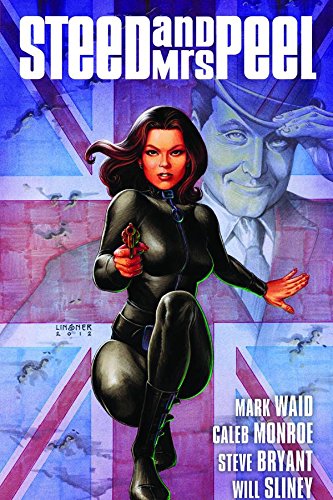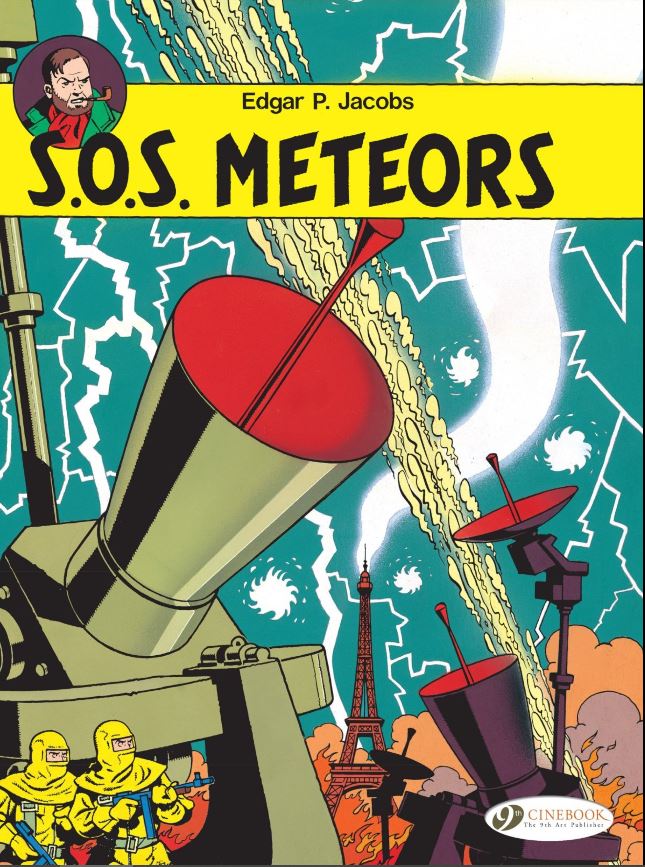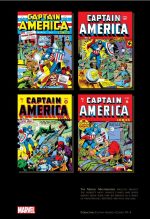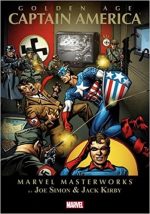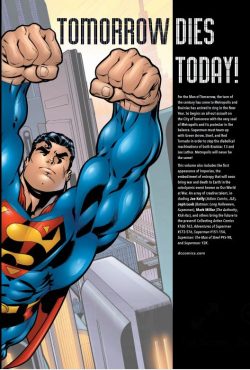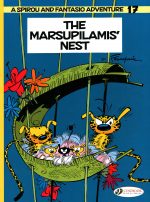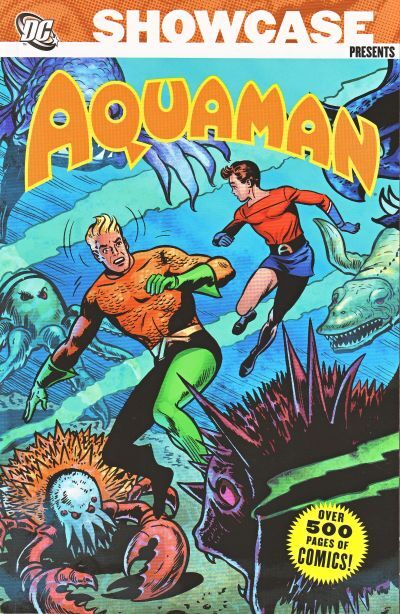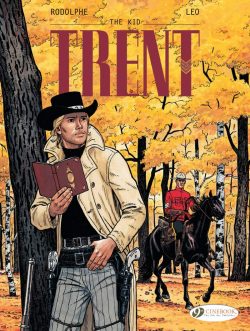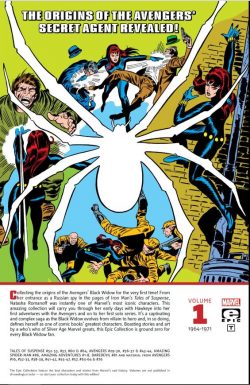
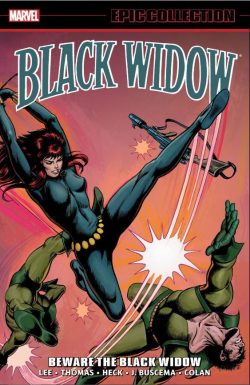
By Stan Lee, Don Rico & Don Heck, Roy Thomas, Gary Friedrich, Mimi Gold, Gerry Conway, Jack Kirby, John Buscema, John Romita, Gene Colan, Bill Everett & various (Marvel)
ISBN: 978-1-3029-2126-2 (TPB)
After a truly interminable time of waiting, the Black Widow movie is scheduled for general release on July 9th, so lets all take a look at her comic path from wicked wanton to war-weary world-saver courtesy of a carefully curated Epic Collection, gathering the majority of her earliest appearances.
Natasha Romanoff (sometimes Natalia Romanova) is a Soviet Russian spy who came in from the cold and stuck around to become one of Marvel’s earliest female stars. The Black Widow started life as a svelte, sultry honey-trap during Marvel’s early “Commie-busting†days, targeting Tony Stark and battling Iron Man in her debut (Tales of Suspense #52, April, 1964).
She was subsequently redesigned as a torrid tights-&-tech super-villain before defecting to the USA, falling for an assortment of Yankee superheroes – including Hawkeye and Daredevil – before finally enlisting as an agent of S.H.I.E.L.D., setting up as a freelance do-gooder and joining/occasionally leading the Avengers.
Throughout her career she has always been considered ultra-efficient, coldly competent, deadly dangerous and yet somehow cursed to bring doom and disaster to her paramours. As her backstory evolved, it was revealed that Natasha had undergone experimental processes which enhanced her physical capabilities and lengthened her lifespan, as well as assorted psychological procedures which had messed up her mind and memories…
Traditionally a minor fan favourite, the Widow only really hit the big time after Marvel Movie franchise was established, but for us unregenerate comics-addicts her print escapades have always offered a cool, sinister frisson of delight.
This expansive trade paperback and digital compilation gathers the contents of Tales of Suspense #52-53, 57, 60, 64; Avengers #29-30, 36-37, 43-44; Amazing Spider-Man #86; Amazing Adventures #1-8 and Daredevil #81, plus pertinent excerpts from Avengers #16, 32-33, 38-39, 41-42, 45-47, 57, 63-63 & 76, cumulatively spanning April 1964 to November 1971.
The action opens as a sexy Soviet operative Natasha and her hulking sidekick Boris (yes, I know: simpler times) is despatched to destroy recent defector Anton Vanko and his American protectors Tony Stark and Iron Man. ‘The Crimson Dynamo Strikes Again!’ (drawn by Don Heck and scripted, like the next issue, by “N. Kurok†– actually veteran creator Don Rico) sees the hero quickly dispose of the armoured Russian heavy while underestimating the far greater threat of the Soviet Femme Fatale.
With Tales of Suspense #53, she was a headliner. In ‘The Black Widow Strikes Again!’ she steals Stark’s anti-gravity ray yet ultimately fails in her sabotage mission, fleeing Russian retribution until resurfacing in ToS #57.
The Black Widow returned to beguile disgruntled budding superhero ‘Hawkeye, The Marksman!’ (Stan Lee & Heck) into attacking the Golden Avenger in #57, with no appreciable effect.
Tales of Suspense #60 featured an extended plotline with Stark’s “disappearance†leading to Iron Man being ‘Suspected of Murder!’. Capitalizing on the chaos, lovestruck Hawkeye and the Widow struck again, but another failure led to her being recaptured and re-educated by enemy agents…
Abruptly transformed from fur-clad seductress into a gadget-laden costumed villain, she returned in #64’s ‘Hawkeye and the New Black Widow Strike Again!’ (Lee, Heck & Chic Stone). Her failure led to big changes as pages from Avengers #16 reveal her punishment and Hawkeye’s reformation and induction into the superteam.
Jump forward more than a year and Avengers #29 as Quicksilver and the Scarlet Witch prepare to retire: returning to Europe to reinvigorate their fading powers even as ‘This Power Unleashed!’ brings back Hawkeye’s lost love: a brainwashed nemesis resolved to destroy the team.
Recruiting old foes Power Man and the Swordsman as cannon-fodder, she is foiled by her own incompletely submerged feelings for Hawkeye, after which ‘Frenzy in a Far-Off Land!’ sees dispirited colossus Henry Pym embroiled in a futuristic civil war amongst a lost south American civilisation while a temporary détente between Hawkeye and the Widow seems set to fail…
Extracts from Avengers #32-33 (with Heck providing raw, gritty inks over his own pencils in ‘The Sign of the Serpent!’ and concluding chapter ‘To Smash a Serpent!’) sees her own recovery begin as Natasha independently infiltrates a racist secret society before joining the Avengers to destroy the hatemongering snakes…
Her international credentials are exploited when long-missing Scarlet Witch and Quicksilver return, heralding an alien invasion of the Balkans in ‘The Ultroids Attack!’ and ‘To Conquer a Colossus!’ (Avengers #36-37). Newly cured, programming-free and reformed, she is the crucial factor in repelling an extraterrestrial invasion: a sinister, merciless Black Widow whose willingness to apply lethal force ultimately saves the day and the Earth……
Extracts from Avengers #38, 39, 41 and 42 detail how she then forsakes her new heroic reputation to go undercover for SHIELD, infiltrating a Communist Chinese super-weapon project as a supposed Soviet agent. In #43’s complete tale ‘Color him… the Red Guardian!’ (Roy Thomas, John Buscema & George Roussos) her origins and reasons for the title “widow†are revealed before – reacting to a world-threatening superweapon – the Avengers storm in for the fight of their lives as the saga climaxes in ‘The Valiant Also Die!’ (inked by Vince Colletta), a blistering all-out clash to save humanity from mental conquest…
The fractured relationship between Hawkeye and the Widow plays out in snippets from Avengers #45-47, #63 and 64 as her growing ties to SHIELD lead to an heartbreaking split with the Avenging Archer in #76 and the prospect of a new beginning for the Russian misfit…
It comes in Amazing Spider-Man #86 as ‘Beware… the Black Widow!’ affords John Romita & Jim Mooney a chance to redesign, redefine and relaunch the super-spy in an enjoyable if formulaic Lee-scripted misunderstanding/clash-of-heroes yarn with an ailing webspinner never really endangered. The entire episode was actually a promotion for the Widow’s own soon-to-debut solo series…
The Black Widow‘s first solo series, appeared in “split-book†Amazing Adventures #1-8: mini-epics paying dues the superspy’s contemporary influences… Modesty Blaise and Emma Peel (that lass from the other Avengers…)
It all begins with ‘Then Came…The Black Widow’ (Amazing Adventures #1, August 1970 by Gary Friedrich, John Buscema & John Verpoorten) wherein Natasha comes out of self-imposed retirement to be a socially-aware crusader: defending low-income citizens from thugs and loan sharks. One act of charity leads her to help activists ‘The Young Warriors!’ as their attempts to build a centre for underprivileged kids in Spanish Harlem are countered by crooked, drug-dealing property speculators…
Gene Colan & Bill Everett assume art duties from #3’s ‘The Widow and the Militants!’, with her actions and communist past drawing hostile media attention, more criminal attacks and ultimately precipitating an inner-city siege, before the ‘Deadlock’ (scripted by Mimi Gold) comes to a shocking end…
Roy Thomas steps in for a bleakly potent Christmas yarn as ‘…And to All a Good Night’ sees Natasha and faithful retainer/father figure Ivan meet and fail a desperate young man, only to be dragged into a horrific scheme by deranged cult leader the Astrologer who plans to hold the city’s hospitals to ransom in ‘Blood Will Tell!’ (art by Heck & Sal Buscema).
Convinced she is cursed to do more harm than good, the tragic adventurer nevertheless inflicts ‘The Sting of the Widow!’(Gerry Conway, Heck & Everett) on her ruthless prey and his kid warriors, after which the series wraps up in rushed manner with a haphazard duel against Russian-hating super-patriot Watchlord in the Thomas-scripted ‘How Shall I Kill Thee? Let Me Count the Ways!’
The formative tales conclude here with ‘And Death is a Woman Called Widow’ (Daredevil #81, by Conway, Colan & Jack Abel), which sees infamous defector Natasha Romanoff burst onto the scene to save the Man Without Fear from ubiquitous manipulator Mr. Kline and deadly predator The Owl: exposing the mastermind behind most of DD and the Widow’s recent woes and tribulations…
Rounding out the comics experience here are bonus pages including a stunning pin-up of the bodacious Black Widow by Bill Everett; house ads and a huge gallery of original art pages by John Buscema, Verpoorten, Heck, Colan and Everett – including restored artworks edited for overly-salacious content that revealed a little too much of the sexy spy, and toned down for eventual publication…
These beautifully limned yarns might still occasionally jar with their earnest stridency and dated attitudes, but the narrative energy and sheer exuberant excitement of the adventures are compelling delights no action fan will care to miss …
© 2020 MARVEL.



